Wooden kitchen gadgets have long been cherished for their timeless charm and practical benefits. In today’s fast-paced world, where kitchen tools come in a variety of materials, wooden kitchen gadgets stand out for their eco-friendliness, durability, and aesthetic appeal. This complete guide explores the many advantages of using wooden kitchen utensils, the different types available, and tips on how to care for them. Whether you’re an experienced chef or a home cook, incorporating wooden gadgets into your kitchen can enhance your cooking experience and add a touch of natural beauty to your culinary space.
Benefits of Wooden Kitchen Gadgets

Natural and Eco-friendly
Wooden kitchen gadgets are made from renewable resources, making them an eco-friendly choice. Unlike plastic or metal utensils, wood is biodegradable and doesn’t contribute to landfill waste. By opting for wooden utensils, you’re making a positive impact on the environment.
Gentle on Cookware
One of the most significant advantages of wooden kitchen gadgets is their gentle touch on cookware. Wooden spoons and spatulas won’t scratch or damage non-stick pans, cast iron skillets, or other delicate surfaces. This ensures your cookware lasts longer and remains in good condition.
Durability and Longevity
Wooden kitchen gadgets are incredibly durable and can last for many years with proper care. They are resistant to heat and won’t melt like plastic utensils. High-quality wooden utensils, especially those made from hardwoods like maple or teak, can withstand daily use and retain their shape and functionality.
Aesthetic Appeal
There’s no denying the aesthetic appeal of wooden kitchen gadgets. They bring a natural, rustic charm to any kitchen. Wooden utensils can complement various kitchen styles, from modern to traditional, adding a touch of warmth and elegance.
Comfortable to Use
Wooden utensils are comfortable to hold and use. They offer a good grip and are often ergonomically designed to fit comfortably in your hand. This makes stirring, mixing, and serving food easier and more enjoyable.
Types of Wooden Kitchen Gadgets

Cooking Spoons and Spatulas
Wooden cooking spoons and spatulas are essential tools in any kitchen. They are perfect for stirring, mixing, and serving a variety of dishes. Wooden spoons are ideal for cooking soups, sauces, and stews, while spatulas are great for flipping and turning foods without scratching your cookware.
Cutting Boards
Wooden cutting boards are a must-have for any kitchen. They provide a sturdy surface for chopping vegetables, fruits, and meats. Wooden cutting boards are gentle on knife blades, helping them stay sharper for longer. They also add a rustic touch to your kitchen decor.
Rolling Pins
Wooden rolling pins are indispensable for baking enthusiasts. They are used to roll out dough for pastries, cookies, and bread. Wooden rolling pins offer a smooth surface and even weight distribution, making it easier to achieve the desired dough thickness.
Salad Bowls and Tongs
Wooden salad bowls and tongs add an elegant touch to your dining table. They are perfect for tossing and serving salads. The natural texture of wood complements the freshness of salads, making them more appealing.
Mortar and Pestle
A wooden mortar and pestle is a traditional tool used for grinding and crushing spices, herbs, and other ingredients. It is perfect for making pesto, guacamole, and other pastes. The textured surface of the wood helps in breaking down ingredients effectively.
What is a Wooden Utensil Used in the Kitchen?
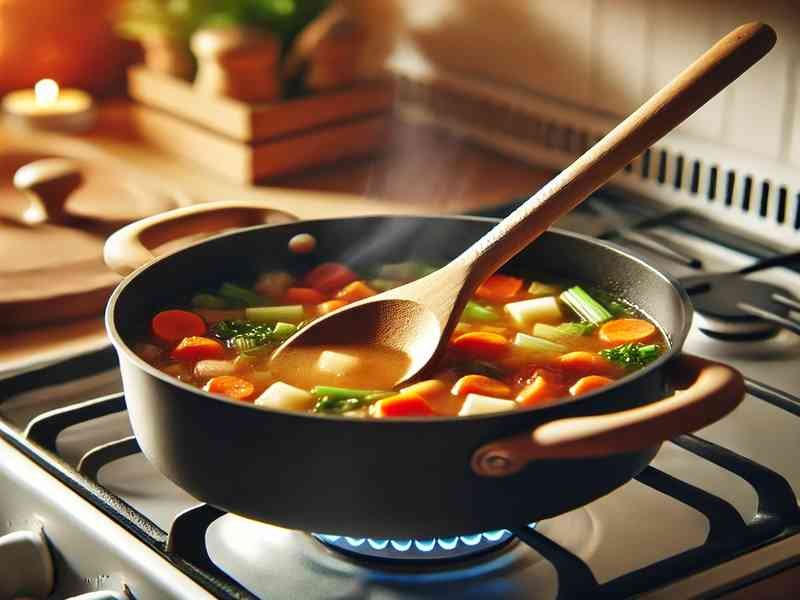
Wooden kitchen gadgets have been a staple in kitchens for centuries due to their versatility, durability, and aesthetic appeal. But what exactly is a wooden utensil used for in the kitchen? Let’s explore the various uses of wooden utensils and why they remain popular among home cooks and professional chefs alike.
Stirring and Mixing
One of the most common uses of wooden utensils is for stirring and mixing ingredients. Wooden spoons and spatulas are perfect for stirring soups, sauces, and stews. They are gentle on pots and pans, especially non-stick cookware, preventing scratches and damage.
Cooking and Sautéing
Wooden utensils are excellent for cooking and sautéing a variety of dishes. Their natural heat resistance means they won’t conduct heat, making them safe to use in hot pans. Whether you’re flipping vegetables or turning pieces of meat, wooden spatulas and turners are ideal for the task.
Serving Food
Wooden utensils are also commonly used for serving food. Wooden salad servers, tongs, and ladles are great for dishing out salads, pastas, and other dishes. Their elegant appearance makes them suitable for both everyday meals and special occasions.
Baking
Bakers often use wooden utensils like rolling pins and dough scrapers. Wooden rolling pins provide a smooth surface for rolling out dough, while wooden dough scrapers help in handling and shaping the dough. These tools are essential for making pastries, bread, and other baked goods.
Crushing and Grinding
Wooden mortars and pestles are traditional tools used for crushing and grinding spices, herbs, and other ingredients. They are perfect for making fresh pesto, grinding spices for recipes, and even preparing homemade medicines.
What are Kitchen Gadgets Called?
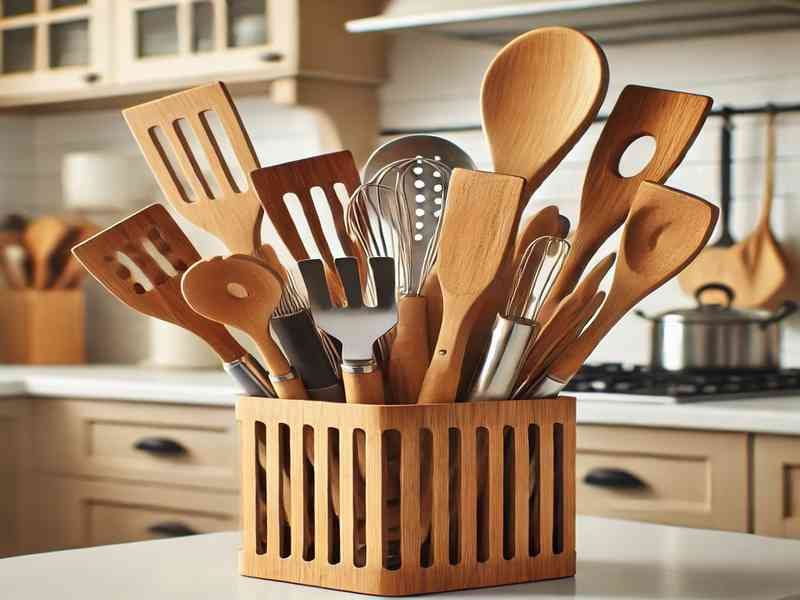
Kitchen gadgets are essential tools that make cooking and food preparation more efficient and enjoyable. They come in various forms and serve different purposes, helping to streamline tasks and enhance the overall cooking experience. But what are kitchen gadgets called, and how do they differ from one another? Let’s explore this in detail.
Common Terms for Kitchen Gadgets
Utensils
Kitchen utensils are tools used for food preparation. This category includes items like wooden spoons, spatulas, tongs, whisks, and ladles. These are basic tools that are essential for everyday cooking tasks.
Appliances
Kitchen appliances are larger, often electric devices used for specific tasks. Examples include blenders, mixers, food processors, and coffee makers. These gadgets typically require a power source and offer more complex functionality.
Tools
Kitchen tools are a broad category that includes any instrument used to perform a kitchen task. This can range from manual tools like peelers and graters to more specialized items like meat thermometers and garlic presses.
Devices
Kitchen devices often refer to both manual and electric gadgets that assist in food preparation. This term is somewhat interchangeable with tools and appliances but can also include gadgets like timers, scales, and thermometers.
Equipment
Kitchen equipment generally refers to the larger and more durable items in the kitchen, such as ovens, stoves, refrigerators, and dishwashers. These are essential for the overall operation of a kitchen.
Categories of Kitchen Gadgets
Cutting and Chopping Tools
Knives, cutting boards, and choppers
Mixing and Baking Tools
Mixing bowls, wooden spoons, and rolling pins
Cooking and Serving Tools
Spatulas, spoons, and tongs
Measuring Tools
Measuring cups, spoons, and scales
Specialty Tools
Peelers, graters, and zesters
Five Main Categories of Kitchen Utensils
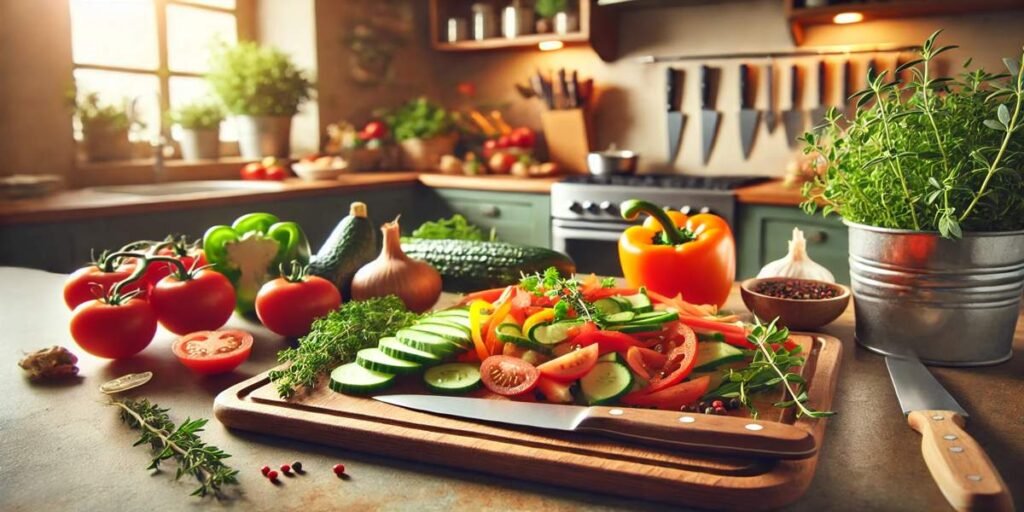
Kitchen utensils are essential tools that help make food preparation and cooking more efficient and enjoyable. Understanding the different categories of kitchen utensils can help you organize your kitchen better and ensure you have the right tools for every task. Here are the five main categories of kitchen utensils:
Cutting and Chopping Tools
Cutting and chopping tools are fundamental in any kitchen. These utensils prepare ingredients by cutting, slicing, dicing, and chopping. Common tools in this category include:
- Knives: Chef’s knives, paring knives, serrated knives, and carving knives.
- Cutting Boards: Wooden cutting boards are particularly popular due to their durability and gentleness on knife blades.
- Choppers and Slicers: Manual or electric choppers and mandoline slicers.
Mixing and Baking Tools
Mixing and baking tools are essential for combining ingredients and preparing dough and batter. This category includes:
Mixing Bowls: Wooden, metal, or glass bowls for mixing ingredients.
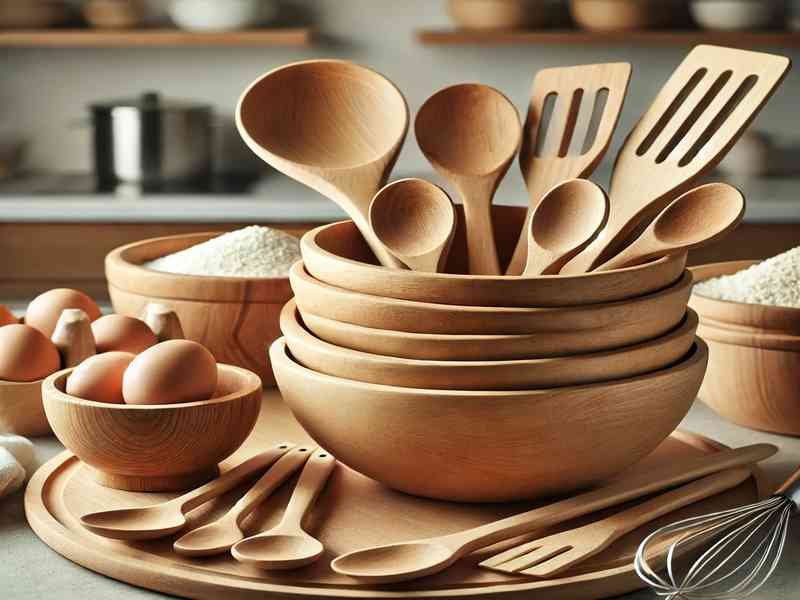
Mixing bowls are essential kitchen tools that come in various materials, including wooden, metal, and glass. Each type of bowl has its own unique properties and advantages, making them suitable for different cooking and baking tasks. Whether you’re mixing dough, tossing salads, or preparing ingredients for your favorite recipes, the right mixing bowl can make a significant difference in your culinary experience. Let’s explore the characteristics and uses of wooden, metal, and glass mixing bowls.
Cooking and Serving Tools
Cooking and serving tools help in the actual cooking process and in serving the prepared dishes. This category includes:
- Spatulas and Turners: Used for flipping and turning food while cooking.
- Ladles and Serving Spoons: Ideal for serving soups, stews, and sauces.
- Tongs: Used for lifting and turning hot foods.
Measuring Tools
Accurate measurements are crucial for successful cooking and baking. Measuring tools help in measuring both dry and liquid ingredients. This category includes:
- Measuring Cups and Spoons: For measuring small and large quantities of ingredients.
- Kitchen Scales: Used for weighing ingredients precisely.
- Liquid Measuring Jugs: Specifically designed for measuring liquids.
Specialty Tools
Speciality tools are designed for specific tasks and can make certain kitchen jobs easier and more efficient. This category includes:
- Peelers and Graters: For peeling vegetables and grating cheese or zest.
- Garlic Presses and Zesters: For mincing garlic and zesting citrus fruits.
- Mortar and Pestle: Used for grinding and crushing spices and herbs.
Best Wood for Kitchen Utensils
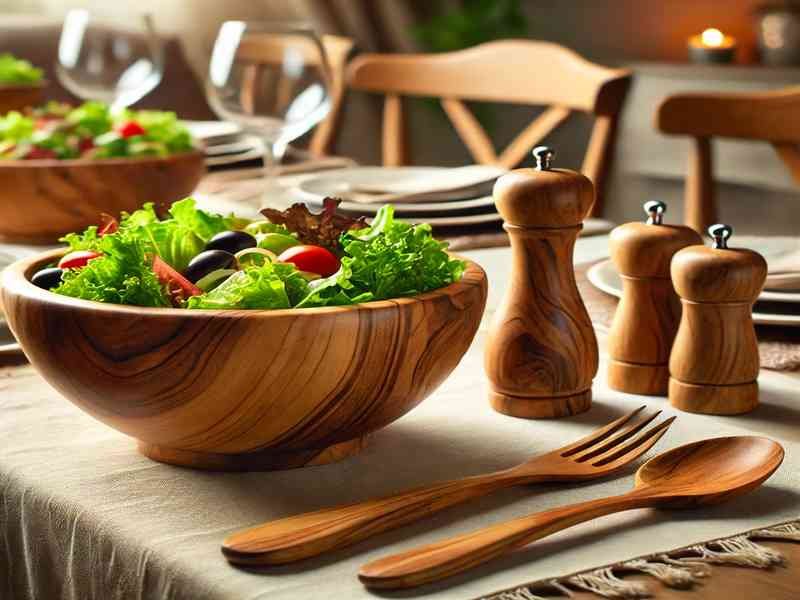
When it comes to selecting wooden kitchen gadgets, the type of wood used plays a significant role in their durability, functionality, and overall appeal. Different woods have unique properties that make them suitable for various kitchen utensils. Here are some of the best woods for kitchen utensils and why they are ideal choices:
Maple
Maple is one of the most popular woods for kitchen utensils. It is a hard, dense wood that resists scratching and denting, making it highly durable. Maple is also non-porous, so it won’t absorb food odours or stains, ensuring your utensils remain hygienic.
Beech
Beechwood is another excellent choice for kitchen gadgets. It has a tight grain and a smooth surface, making it easy to clean. Beechwood is hard and strong, offering great durability. It’s light colour and attractive grain pattern also add a natural charm to kitchen utensils.
Olive Wood
Olive wood is known for its beautiful grain patterns and rich colour. It is a hard, dense wood resistant to stains and odours. Olive wood utensils are functional and add an elegant touch to your kitchen. The natural oils in olive wood also make it resistant to moisture.
Bamboo
Bamboo is a sustainable and eco-friendly choice for kitchen utensils. It is technically a grass, but it is harder than many hardwoods. Bamboo utensils are lightweight, durable, and resistant to stains and odours. Additionally, bamboo is a renewable resource, making it an environmentally responsible choice.
Teak
Teak wood is highly prized for its durability and resistance to moisture. It contains natural oils that protect it from water damage, making it an ideal choice for kitchen utensils that come into contact with liquids. Teak’s beautiful grain and rich colour make it a popular choice for functional and decorative kitchen gadgets.
Maintenance and Care for Wooden Kitchen Gadgets
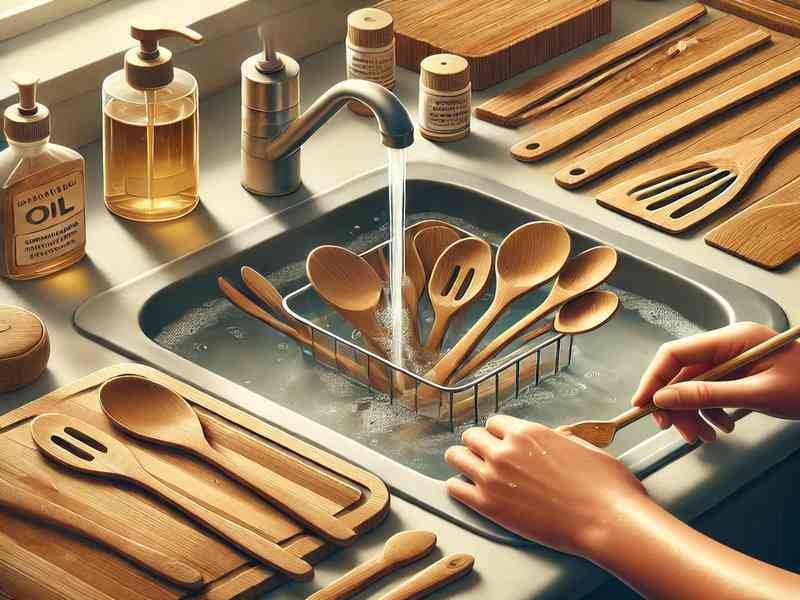
To enjoy the benefits of wooden kitchen gadgets fully, it’s essential to maintain and care for them properly. Regular cleaning, seasoning, and proper storage will ensure they last for years and continue to provide excellent performance.
Cleaning Tips
- Hand wash wooden utensils with mild soap and warm water.
- Avoid soaking them in water to prevent warping or cracking.
- Dry thoroughly with a clean towel after washing.
Seasoning and Oiling
- Apply food-grade mineral oil or beeswax to wooden utensils to maintain their finish and prevent drying out.
- Regularly oil your utensils to keep the wood conditioned and water-resistant.
Storage Advice
- Store wooden utensils in a dry, cool place.
- Avoid exposing them to extreme temperatures or humidity.
- Keep them away from direct sunlight to prevent fading and cracking.
Comparing Wooden Kitchen Gadgets to Other Materials

Wood vs. Plastic
Wooden utensils are more environmentally friendly and durable compared to plastic. They do not leach harmful chemicals into food and have a longer lifespan with proper care.
Wood vs. Metal
Wooden utensils are gentle on cookware and do not conduct heat, making them safer for hot foods. On the other hand, metal utensils can scratch non-stick surfaces and become hot to the touch.
Wood vs. Silicone
While silicone utensils are heat-resistant and flexible, wooden utensils offer a natural aesthetic and are biodegradable. Both materials have advantages, but wooden utensils provide a timeless appeal and environmental benefits.
Conclusion
Wooden kitchen gadgets are functional, environmentally friendly, gentle on cookware, durable, and aesthetically pleasing. Incorporating wooden utensils into your kitchen allows you to enjoy these numerous benefits while adding a touch of natural beauty to your culinary space. Whether you’re a seasoned chef or a home cook, wooden utensils can enhance your culinary experience and add a touch of warmth to your kitchen.


Pingback: Top 10 Home Gym Weight Sets for Every Budget: Get Fit at Home - Amazhom